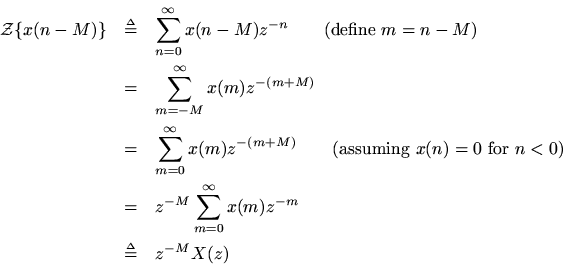NOTE: THIS DOCUMENT IS OBSOLETE, PLEASE CHECK THE NEW VERSION: "Mathematics of the Discrete Fourier Transform (DFT), with Audio Applications --- Second Edition", by Julius O. Smith III, W3K Publishing, 2007, ISBN 978-0-9745607-4-8. - Copyright © 2017-09-28 by Julius O. Smith III - Center for Computer Research in Music and Acoustics (CCRMA), Stanford University
<< Previous page TOC INDEX Next page >>
Convolution Representation of LTI FiltersIf
is the output of an LTI filter with input
and impulse response
, then
is the convolution of
with
,
Since convolution is commutative (), we have also
Definition. The unilateral
Thattransform of the discrete-time signal
is defined to be
and
are transform pairs is expressed by writing
or
.
Theorem. The convolution theorem (Papoulis [21]) states that
In words, convolution in the time domain is multiplication in the frequency domain.Taking the
transform of both sides of Eq. (B.4.3) and applying the convolution theorem gives
whereis the
transform of the filter impulse response. Thus the
transform of the filter output is the
transform of the input times the
transform of the impulse response.
Definition. The transfer function
of a linear time-invariant discrete-time filter is defined to be the
transform of the impulse response
.
Theorem. The shift theorem [21] for
transforms states that
The shift theorem can be derived immediately from the definition of thetransformgiven in Eq. (
):
The general difference equation for an LTI filter appears as
(B.10) (B.11)
Taking thetransform of both sides, denoting the transform by
, gives
(B.12) (B.13)
using linearity and the shift theorem. Replacingby
,
by
, and moving the terms in
to the left-hand side, we obtain
(B.14) (B.15)
or
(B.16) (B.17)
Defining the polynomials
(B.18) (B.19)
thetransform of the difference equation becomes
Finally, solving forwhich equals the transfer function
, yields




